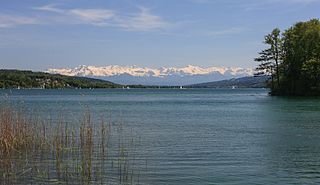
The canton of Aargau is one of the more northerly cantons of Switzerland. It is situated by the lower course of the Aare, which is why the canton is called Aar-gau. It is one of the most densely populated regions of Switzerland.

Beinwil am See is a municipality in the district of Kulm in the canton of Aargau in Switzerland.
Kulm District is a district in the canton of Aargau, Switzerland. It is located west of Lake Hallwil and covers parts of the Wyna and Suhre valleys. The principal town is Unterkulm; the largest municipality is Reinach. The district contains 17 municipalities, is 101.35 km² in area and has a population of 41,029.

Lake Hallwil is a lake largely in the Canton of Aargau, Switzerland, located at 47°17′N8°12′E. It is the largest lake in Aargau and lies mostly in the districts of Lenzburg and Kulm on the southern edge of the canton. The southern tip of the lake reaches into the canton of Lucerne. The main river leading to this lake is the Aabach, which is coming from the Lake Baldegg.

Boniswil is a municipality in the district of Lenzburg in the canton of Aargau in Switzerland.

Hallwil is a municipality in the district of Lenzburg in the canton of Aargau in Switzerland.

Seengen is a municipality in the district of Lenzburg in the canton of Aargau in Switzerland.
The Sarner Aa is a 28 km (17 mi) long river in the Swiss canton of Obwalden. It drains the area to the eastern side of the Brünig Pass, flowing through the Lake Lungern, Lake Sarnen and the Wichelsee, before entering Lake Lucerne near Alpnach. It goes by several names over its length, being known as the Lauibach upstream of the Lungerersee, and the Aa or Aawasser between the Lungerersee and Lake Sarnen.

Egelsee is a lake at Bergdietikon, Aargau, Switzerland. Its surface area is 2 ha. It is the largest natural lake that lies entirely in the canton.

The Wyna is a river located mostly in canton of Aargau, but also in canton of Lucerne, Switzerland and runs through the Wynetal. It is a tributary of the Suhre. The Wyna is 32 km long. Larger towns in Wynetal are Beromünster, Menziken, Reinach (AG) and Gränichen.

The Wynental and Suhrental Railway is a privately owned narrow gauge railway company in the canton of Aargau in Switzerland. It operates under the brand Aargau Verkehr AG (AVA), together with the BDWM Transport

The river Suhre is a 34 kilometer long tributary of the river Aare in the Swiss cantons of Lucerne and Aargau. The river rises in Sempachersee at an altitude of 504 meters above sea level, and joins the Aare east of the town Aarau at an altitude of 362 meters. The most important side valley is the Ruedertal, which joins the Suhretal at Schöftland.

The Aabach is a small river that runs through the Swiss cantons of Lucerne and Aargau, in the Aare catchment area. It flows from south to north through the valley called Seetal and ends in the Aare.

The Lindenberg, peaking at 878 m, is a wooded hill in the Swiss Plateau north of the Alps, situated between the valleys of the Aabach, the Bünz and the Reuss. The hill draws a straight north-south line. On his ridge lies the border between the cantons of Lucerne and Aargau. Although the highest peak lies in the canton of Lucerne in the municipality of Müswangen, around 75% of the hill lies in the Aargau. The highest point is unspectacular as it is very flat and wooded; it can be reached by foot, by bike or even by jeep. Despite being overgrown with large forests and fields, many villages are situated on the hill's slopes and at its base, some of the bigger are Muri AG, Sins, Hochdorf and Hitzkirch. The hill is a frequently used place for bikers, hikers, equestrians and families, as several restaurants exist on various places of the hill. Despite his low altitude for Swiss standards, at some points the view is quite a sight as Lake Zug, Lake Hallwil and Lake Baldegg and prominent Swiss mountains as Säntis, Tödi, Titlis and Finsteraarhorn can be seen from some places, like Horben.

Lenzburg is a railway station in the municipality of Lenzburg in the Swiss canton of Aargau.

Trostburg Castle is a small castle in the municipality of Teufenthal in the canton of Aargau in Switzerland.
The Heitersberg Railway (Heitersbergstrecke) is a Swiss railway line between the stations of Killwangen-Spreitenbach and Aarau on the east-west main line between Zürich und Bern. The main structure of the line is the 4,929 metre-long Heitersberg Tunnel, which has its west portal near Mellingen and its east portal near Killwangen.
The Zofingen–Wettingen railway is a standard-gauge line in Switzerland. It was opened on 6 September 1877 between Zofingen and Baden Oberstadt together with the Aarau–Suhr railway by the Swiss National Railway. The opening of the adjacent Baden Oberstadt–Wettingen section together with the Wettingen–Effretikon railway, which represented its continuation to the east, was delayed until 15 October 1877 due to construction delays at the Limmat bridge. The SNB went bankrupt in 1878, after which the line was acquired by the Swiss Northeastern Railway from the bankrupt estate. The NOB became part of the Swiss Federal Railways with the nationalisation of the company in 1902.


























